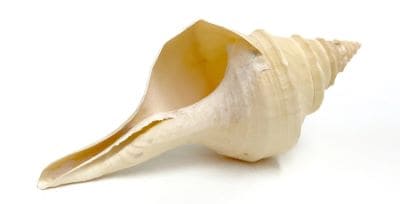Home › Sea Life › Marine › Invertebrates › Mollusks › Snails › Australian Trumpet
Facts about Australian Trumpet Shell Snails
[Phylum: Mollusca] [Class: Gastropoda] [Superfamily: Muricoidea] [Family: Turbinellidae]
There's an enormous sea snail that looks like a giant trumpet, native to the Great Barrier Reef, and so big you can use it to carry water.
This guide contains fun facts about Australian trumpet shells, including their geographical range, feeding habit and how Syrinx aruanus reproduce.
False Trumpet Snail Habitat and Distribution
The best places to find the Australian trumpet shell (aka false trumpet) are northern regions of Australia and bordering areas, especially:
- The Great Barrier Reef (GBR)
- Eastern Indonesia (e.g. Sulawesi, West Nusa)
- Papua New Guinea (PNG)
These marine gastropod mollusks live in the sand and muddy substrate of intertidal and sublittoral zones (shallower than 30 metres).
Marine biologists consider it as being the longest, and heaviest, shelled species of living gastropods found anywhere around the world (excluding fossilised shells).
Nonetheless, divers will need to have sharp eyes to spot them. Australian trumpet shells enjoy being buried, often completely out of sight, in the gold-coloured sands of tropical and subtropical coral reefs and shallow coastal water marine habitats.
Pro Tip: The main section contains more sea snail facts and information, including the vital role that marine snails have in saltwater seas and oceans around the world.
Syrinx Aruanus Characteristics and Behaviour
The solid and robust shell, covered with thick brown or grey periostracum, helps to protect the fragile body of the Australian trumpet snail.
Similar to most species of sea snail, it has a strong keel at the base of the whorled growth and an extremely long siphonal canal.
The colour of the outer case is usually a light beige, creamy yellow, or pastel grey. A few darker spots camouflage the shell against the snail's sandy environment.
 Its luminous, somewhat iridescent, and opalescent interior distinguishes the Australian trumpet from many of its close relatives (Turbinellidae).
Its luminous, somewhat iridescent, and opalescent interior distinguishes the Australian trumpet from many of its close relatives (Turbinellidae).
Here's the thing:
This gigantic conical shell gets its taxonomic name from its resemblance to a trumpet (or French horn).
Furthermore, the Registry of World Record Size Shells (WRS Shells) declares it as being the largest living specimen.
As a consequence of that, the biggest Australian trumpet shell (Syrinx aruanus) ever recorded measured a mighty 72.2 centimetres long (over 28 inches) and weighed eighteen (18) kilograms (40 pounds).
These remarkable examples of invertebrates use a large, muscular, ventral foot to propel their body. It comes into view as it extends forward out of the shell and pushes the snail along the ocean floor
What Do Australian Trumpet Shells Eat?
These marine predators use a long flexible tube (a proboscis) to capture and devour prey. By and large, Australian trumpet shells eat most marine invertebrates, especially:
- Annelid worms (e.g. Loimia, Diopatra)
- Bivalve mollusks
- Decaying organic material (detritus)
Fun Fact: Marine prosobranch gastropods transfer organic material towards the edge of their gills. They consume it as a source of food through a process called deposit feeding or suspension.
Marine Snail Reproductive Process
Most species of sea snail start to breed in May and June when the water gets warmer. Thus, females tend to spawn no more than twice a year - and usually following neap tides.
Many snails are sequential hermaphrodites, which means each individual begins life as a male and transforms into a female in later life.
After fertilising the eggs "internally", each female disperses thousands of veligers (microscopic swimming larvae). Some of the larvae will escape predators and settle on the ocean floor to metamorphose into adults
Threats and Predators
Human behaviour may be a threat to the long term survival of Syrinx aruanus. Their edible meat is a versatile food source, they are used as fishing bait, and the extraordinary size of the Australian trumpet shell snail means they're valued by collectors.